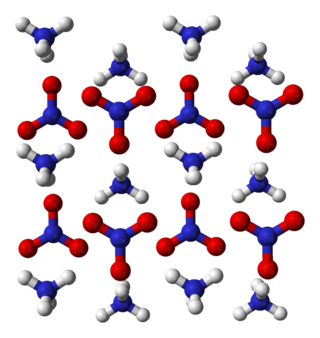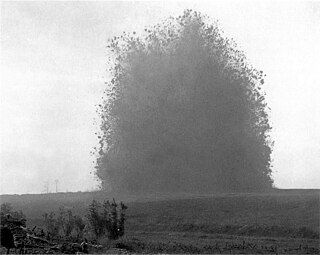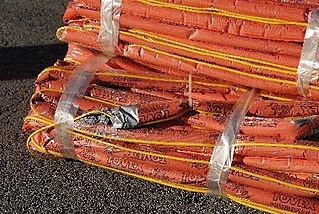Related Research Articles

An explosive is a reactive substance that contains a great amount of potential energy that can produce an explosion if released suddenly, usually accompanied by the production of light, heat, sound, and pressure. An explosive charge is a measured quantity of explosive material, which may either be composed solely of one ingredient or be a mixture containing at least two substances.

Ammonium nitrate is a chemical compound with the formula NH4NO3. It is a white crystalline salt consisting of ions of ammonium and nitrate. It is highly soluble in water and hygroscopic as a solid, although it does not form hydrates. It is predominantly used in agriculture as a high-nitrogen fertilizer.

ANFO ( AN-foh) (or AN/FO, for ammonium nitrate/fuel oil) is a widely used bulk industrial high explosive. It consists of 94% porous prilled ammonium nitrate (NH4NO3) (AN), which acts as the oxidizing agent and absorbent for the fuel, and 6% number 2 fuel oil (FO). The use of ANFO originated in the 1950s.
Cheddite is a class of explosive materials invented in 1897 by E. A. G. Street of the firm of Berges, Corbin et Cie and originally manufactured in the town of Chedde in Haute-Savoie, France, in the early twentieth century.
A prill is a small aggregate or globule of a material, most often a dry sphere, formed from a melted liquid through spray crystallization.

Potassium chlorate is the inorganic compound with the molecular formula KClO3. In its pure form, it is a white solid. After sodium chlorate, it is the second most common chlorate in industrial use. It is a strong oxidizing agent and its most important application is in safety matches. In other applications it is mostly obsolete and has been replaced by safer alternatives in recent decades. It has been used

Nitrobenzene is an aromatic nitro compound and the simplest of the nitrobenzenes, with the chemical formula C6H5NO2. It is a water-insoluble pale yellow oil with an almond-like odor. It freezes to give greenish-yellow crystals. It is produced on a large scale from benzene as a precursor to aniline. In the laboratory, it is occasionally used as a solvent, especially for electrophilic reagents. As confirmed by X-ray crystallography, nitrobenzene is a planar molecule.

Ammonal is an explosive made up of ammonium nitrate and aluminium powder. TNT is added to create T-ammonal which improves properties such as brisance. The mixture is often referred to as Tannerite, which is a brand of ammonal.

Flash powder is a pyrotechnic composition, a mixture of oxidizer and metallic fuel, which burns quickly (deflagrates) and produces a loud noise regardless of confinement. It is widely used in theatrical pyrotechnics and fireworks and was once used for flashes in photography.
An Oxyliquit, also called liquid air explosive or liquid oxygen explosive, is an explosive material which is a mixture of liquid oxygen (LOX) with a suitable fuel, such as carbon, or an organic chemical, wood meal, or aluminium powder or sponge. It is a class of Sprengel explosives.
Kinetite was an explosive material patented in 1884 by T. Petry and O. Fallenstein, It consisted of nitrobenzene thickened or gelatinised by the addition of some collodion-cotton incorporated with finely ground potassium chlorate and precipitated antimony sulphide. It is an orange coloured, plastic mass, with the characteristic strong smell of nitro-benzol. It was manufactured by dissolving gun cotton in nitrobenzene.
Panclastites are a class of Sprengel explosives similar to oxyliquits. They were first suggested in 1881 by Eugène Turpin, a French chemist. They are a mixture of liquid dinitrogen tetroxide serving as oxidizer with a suitable fuel, e.g. carbon disulfide, in the 3:2 volume ratio. Archived 2008-12-01 at the Wayback Machine Other fuel being used is nitrobenzene. Possible alternative fuels are e.g. nitrotoluene, gasoline, nitromethane, or halocarbons.
A pyrotechnic composition is a substance or mixture of substances designed to produce an effect by heat, light, sound, gas/smoke or a combination of these, as a result of non-detonative self-sustaining exothermic chemical reactions. Pyrotechnic substances do not rely on oxygen from external sources to sustain the reaction.
A binary explosive or two-component explosive is an explosive consisting of two components, neither of which is explosive by itself, which have to be mixed in order to become explosive. Examples of common binary explosives include Oxyliquit, ANFO, Kinestik, Tannerite and ammonal, and FIXOR.
Oxygen balance is an expression that is used to indicate the degree to which an explosive can be oxidized, to determine if an explosive molecule contains enough oxygen to fully oxidize the other atoms in the explosive. For example, fully oxidized carbon forms carbon dioxide, hydrogen forms water, sulfur forms sulfur dioxide, and metals form metal oxides. A molecule is said to have a positive oxygen balance if it contains more oxygen than is needed and a negative oxygen balance if it contains less oxygen than is needed.
Explosive materials are produced in numerous physical forms for their use in mining, engineering, or military applications. The different physical forms and fabrication methods are grouped together in several use forms of explosives.
Explosophores are functional groups in organic chemistry that give organic compounds explosive properties.
Miedziankit is a Polish explosive. It consists of 90% potassium chlorate and 10% kerosene.
Calcium ammonium nitrate or CAN, also known as nitro-limestone or nitrochalk, is a widely used inorganic fertilizer, accounting for 4% of all nitrogen fertilizer used worldwide in 2007.

A water-gel explosive is a fuel-sensitized explosive mixture consisting of an aqueous ammonium nitrate solution that acts as the oxidizer. Water gels that are cap-insensitive are referred to under United States safety regulations as blasting agents. Water gel explosives have a jelly-like consistency and come in sausage-like packing stapled shut on both sides.
References
- ↑ Messel, Rudolph (1907). "Hermann Johann Philipp Sprengel". Journal of the Chemical Society. 91: 661–663.
- ↑ Whitt, Toni (2 June 2006). "The east river is cleaner now and the birds say so". The New York Times. Retrieved 12 Apr 2009.